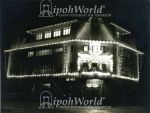We've tried to ensure the information displayed here is as accurate as possible. Should there be any inaccuracies, we would be grateful if you could let us know at info@ipohworld.org . All images and content are copyright.
(Please click on the thumbnail for a bigger image.)
A Night View Of The Perak Chinese Amateur Dramatic Association Building (Which Became The NAAFI)

This is a photograph of the Perak Chinese Amateur Dramatic Association Building. Although the actual date of the photograph is not known, it must have been taken to record a special occasion as the whole building is illuminated and there seems to be an electronic clock on the wall registering 12.41.
The origins of this association dates back to 1903 when a group of junior officials, clerks, bank shroffs and young miners met at the Chinese Union Club at 69 Hale Street to play Cantonese music.
In 1905, the Perak Chinese Dramatic Troupe was formed to put up performances at the Chinese theatre in Leech Street to aid the Canton Flood Relief Fund. After an eventful performance in Kuala Lumpur, the name Perak Chinese Amateur Dramatic Association was adopted. The association building is located right in the middle of Ipoh New Town along Jalan Dato Tahwil Azhar (formerly known as Osborne Street).
They moved several times, staying for eight years at 11 Anderson Road, Ipoh. In 1935, they bought the present site and started a building fund with an initial donation from Wu-Lien Teh, a doctor known as the "Manchurian plague fighter". The Art Deco building was opened in 1938. A large marble tablet inscribed with the names of 221 donors is found on the ground floor.
From September 1945 to April 1946, the Malayan Peoples Anti Japanese Army (MPAJA) took over the building, throwing regular feasts for their fighters with livestock contributed by the country folk. The British Military Administration then requisitioned the entire building from May 1946 for the NAAFI (Navy Army and Air Force Institute) Canteen.
(The latter paragraph is adapted from 1999 Janus Print & Resources - published by the Perak State Government).
More information and photographs may be found at http://www.virtualmalaysia.com/
To read more about Dr Wu Lien Teh, click here.
To find out more about The Malayan People’s Anti-Japanese Army (MPAJA), click here.
To find out more about The British Military Administration (BMA), click here.
To read more about the Ipoh NAAFI, click here